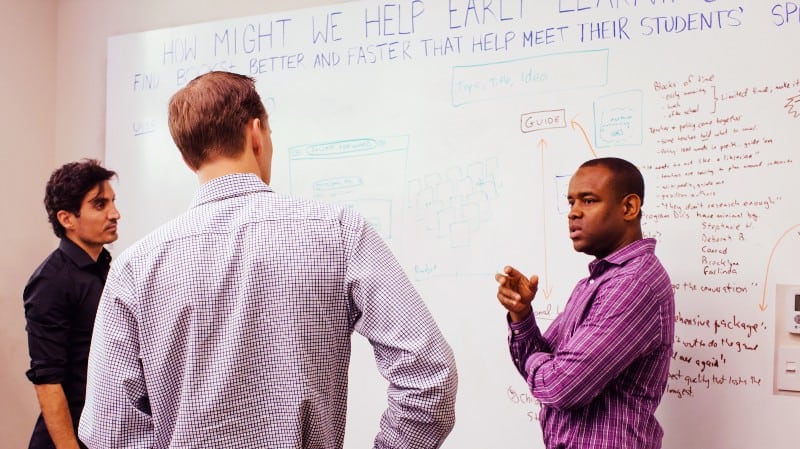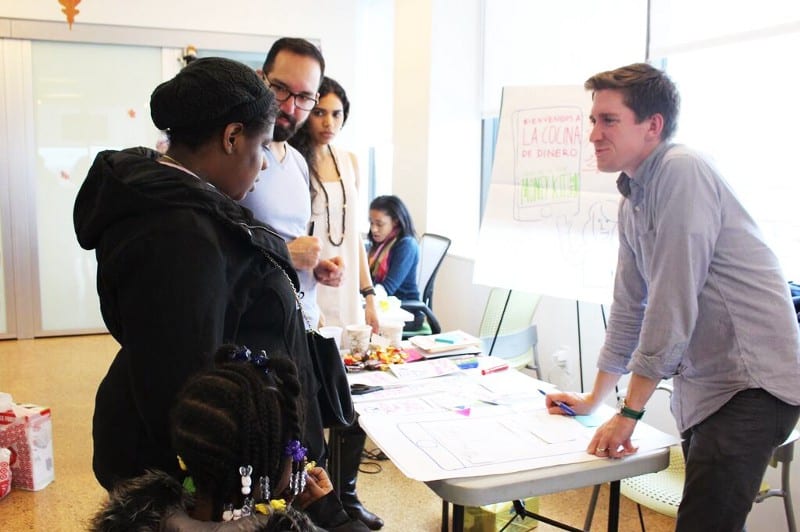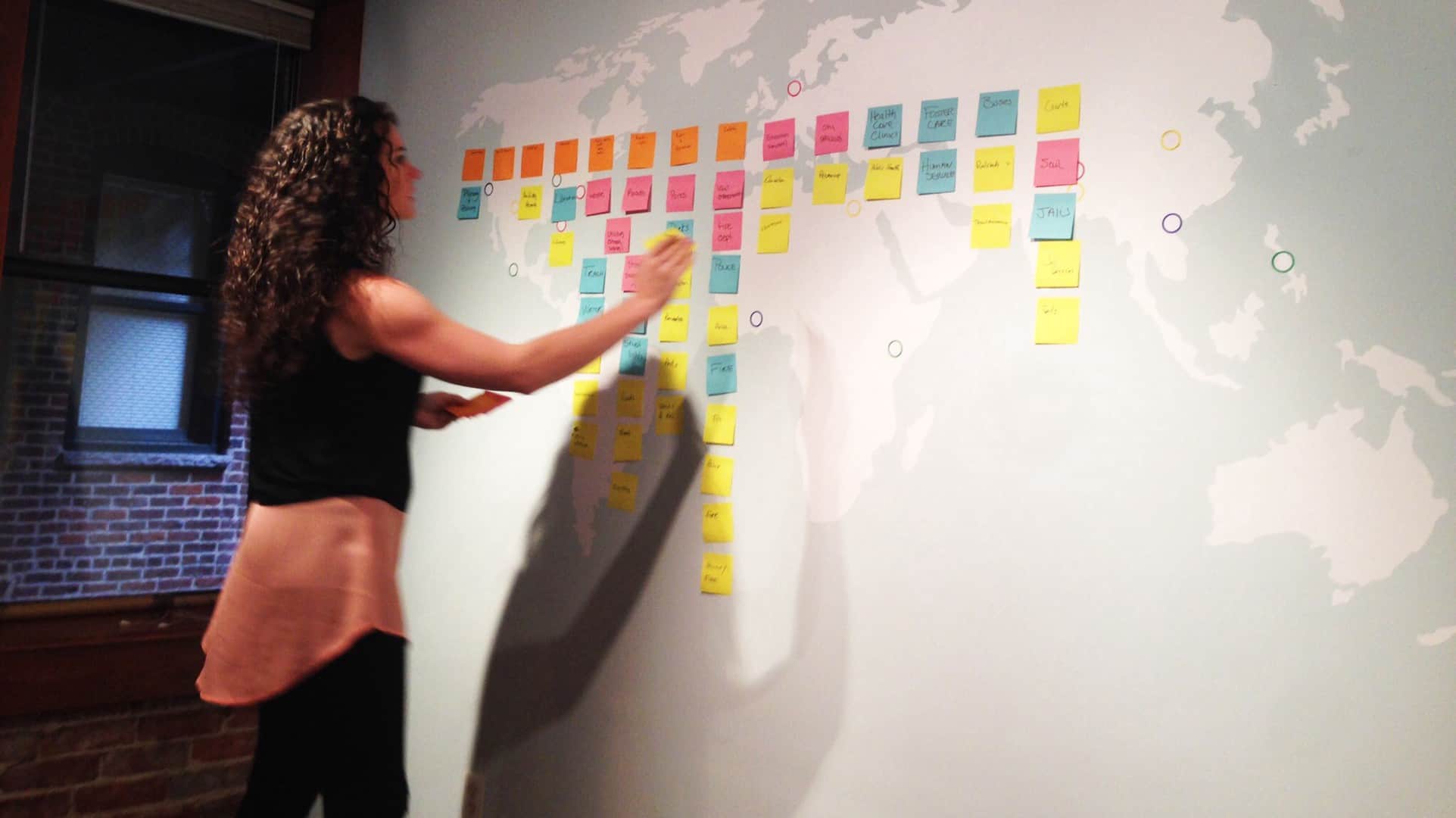Hey gang, welcome back. Hopefully by now you’re really powering with your team and starting to feel the momentum of the process. Last week kicked things off with brainstorming and early research. Now, we’ll focus on confirming the direction, trusting your hunches, experimenting beyond your team, and seeking deeper empathy in your process. So let’s get started!
As you get things going, keep in mind that the expectation for this week is not to walk away with concrete ideas and an exact plan to start building. Rather, the goal should be for the team to uncover enough information and experiences to have a good sense of the best direction to move forward into the Workshop. And keep in mind, our next step is prototyping, so be thinking about that along the way.
Drawing Board #2
As you remember, Drawing Boards are about coming together over ideas as a team, and this week we’ll kick off with another one to rally the team and set the stage for the next few days. Typically for us this session is different than the first — we like to allow for a more open agenda while still making use of the skills worked out in Week 1.
As a starting point, here’s a basic idea to get you going:
- 15 minutes — Confirm the Direction
- 60 minutes — Working Brainstorm
- 15 minutes — Research and Workshop Prep
Total: 90 minutes
15 minutes — Confirm the Direction
By now you’ve probably found several versions of a problem statement, and that is completely OK. We are constantly referring back to what they say and mean, and we’ll encourage you to do the same. Up to this point we’ve been primarily using the problem statement as a starting point, but now, we’ll start using it more as a cornerstone. What we mean is that at this point your problem statement should be something that your work continually stays close to. For example, if you wrote a great problem statement seeking a solution to X, but your work starts to meander towards the solution for Y, looking back on your problem statement will help remind you of your focus.
In between sessions, have you been able to do some of the homework, like reaching out to touchpoints or getting in some early research? If you did, hopefully these experiences and your times together are bringing new insights. Should the problem become more focused? Maybe new learnings are confirming some early thinking? Take the first 15 minutes and confirm the direction of your problem statement as a team. Keep in mind, if you or your team does suggest a modification, be prepared with an insight or finding to back up your suggestion, and get consensus from the team on the revision’s wording.

60 minutes — Working Brainstorm
For reference, look back at the first Drawing Board for some ideas, or feel free to keep this brainstorm flexible based on those first-session principles. Now is the time to start making this process your own, so feel free to go off script here; you’re ready!
No matter your format, the big takeaways for this time are to focus on listening to the team, highlighting hunches, and looking for insights that can drive you towards actionable ideas before the Workshop.
NOTE: As you talk and brainstorm, be sure to listen to others first. Take a cue from the world of improv by using a “Yes, and…” rhythm to your conversation. For example, when a teammate says something, respond with “Yes, I like that! And with that you could…” Listening and being positive will help the team understand that there are no bad ideas.
Trusting your Hunches
At CauseLabs, we love the word hunch. We believe that a hunch should be honored and given the room and resources it deserves. After all, what a hunch really is is your collection of past experiences paired with your current view of the problem, and that should always be important. In this context, it’s a great way to kickstart a brainstorming session: Go around the room and ask everyone what their hunches are. Look for the overlaps — that’s a likely place to pursue next.
Additionally, and this is really important as you start to get towards the end of your brainstorm, start to focus on what not to carry forward from this point. It might sound counterproductive at first, but the truth is, it might be the most important thing you can do with this time. But don’t look at it negatively. Instead, treat this as a time to focus. Building on a concise vision will include many worthy ideas falling to the side, and that is both fine and necessary. A productive way to do this is to create an idea parking lot. While something might not be the best next step, it doesn’t mean it should be forgotten, so park those non-actionable ideas for the moment and come back to them if you pivot in the coming weeks. And on a practical level, this will help you clean your space and let the strongest ideas visually come to the front.
15 minutes — Research and Workshop Prep
As you end the second Drawing Board together, hopefully your team is starting to build upon a select-few ideas and can start to clearly set the vision surrounding next steps. Throughout the rest of this post we’re going to show you what we do next, primarily around research methods and best practices.
It’s important to start preparing for these steps as early as possible, so take this time at the end of your Drawing Board to talk about what time you can dedicate as a team. We’ll get into all of this more in a second, but for now, start thinking about how your team might pair up to work together and what time you have available this week. In the next section we’ll talk about how and what to do by focusing on getting closer to your problem. As we start to build, one idea is far more important than the rest: empathy.
After the Drawing Board:
Research + Empathy
In this next phase of the week we’ll start to step outside of the Drawing Board mindset and shift gears as a team. Keep that creative energy high by doing some much-needed research and extending the vision of the work you’re doing. It might sound scary, but this step is important! As you pair your problem with your hunches and start to think about how to research them, keep this simple idea in mind:
Whenever you can, prove a hunch with a test.
Like we said, your hunches are important, but you should always have the mindset that a hunch isn’t fully valid until you can prove it. After all, even the smallest of tests is a test, so if you have a quick hunch, start with a quick test. This is the start of having a prototyping mindset, and, more importantly, this gets you into the mindset of not looking only at your team as the source of the best ideas. Instead, there’s a world of great ways to keep learning outside yourselves. Here are the ways we use to get there as a team.
- Interviews — This should feel similar to the homework from Week 1, so continue to find people who can help you understand the problem deeper. This could range from an expert in the field to a customer that might use your service, to someone you might meet at random in the neighborhood you’re working in. No matter who you’re talking with, take great notes, listen closely, work hard to keep your own opinions out of the conversation, and try not to ask leading questions. This is about learning from their real experiences, so try to keep your own hunches out of the conversation. It’s best when you bring no more than two people to each interview, and when you’re finished, share back with your team what you learned and organize the thoughts together as you do.
- Co-Create — One simple way to keep learning is to invite others to design and think alongside you. For example, in the photo below, we were working on an app for a specific group of people, so we went to them and co-designed their app individually on large sheets of butcher paper. Each experience was oversized and fun, and let the people we were working for take charge of the design process. It’s also a great interactive interview session, so keep the conversation going and log notes after.

- Analogous Research — Are you building a website? Or maybe it’s a service or program? Take a look at products you enjoy using and review features in them that could inspire the team. During this step, ignore what each is about, but instead,
- look for ideas. For example, we recently worked on a financial inclusion application that needed a great onboarding experience. So we looked at Duolingo, an app for language learning, to find inspiration for how they introduce new customers in a beautiful, simple, engaging way.
- Immersion — Maybe the simplest thing to do is to immerse yourself in your problem. For example, if you’re looking to build a program for a homeless shelter, plan to spend a few hours there observing, listening, and watching, and try to come back for a return visit if you can. You’ll be surprised by what you’ll find, and it will almost certainly teach you something you might not have known to ask about. It may sound obvious, but be sure to get the right approvals, and be respectful of those you might be observing. Take photos carefully and only when allowed.
Empathy
The goal of all of this outside learning is to try to get to a place where you can empathize with the people and problems more deeply. Working with your team in a Drawing Board is absolutely necessary, but it’s almost impossible to build empathy for other people in that setting, so we need to get outside of ourselves (and maybe our comfort zones) to be sure that we can understand this oh-so-important step in the process. As human-centered thinkers, empathy is the drive for everything we do.
In this short video from Design Kit, Emi Kolawole does a beautiful job of explaining empathy and why it’s crucial to this kind of work:
As she notes, it’s more than just putting yourself in someone else’s shoes. Empathy is about trying to embody the hopes, dreams, and desires of someone else like they’re your own. Keep in mind, this entire process only gets better with an empathetic mindset, so start with these small steps, and keep on practicing.
Wrap Up
This week has been full of the most diverse set of skills you’ve needed thus far — congrats on all the progress! As you wrap things up this week, know that much of the hard work is done, but some of the most important parts (like prototyping and roadmapping) are yet to come.
As you finish, document your sessions, and start to brainstorm Workshop experiments. And don’t forget to send out another written recap to encourage your team to keep looking for creative ways to build towards prototyping. And include a funny gif. That’s crucial to success.
More to come next week! See you back here soon.

